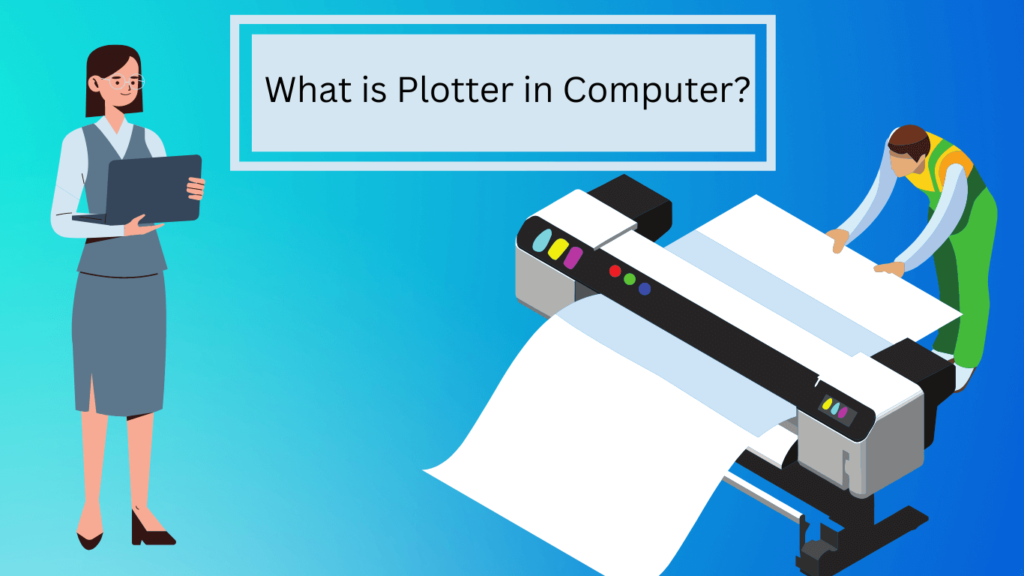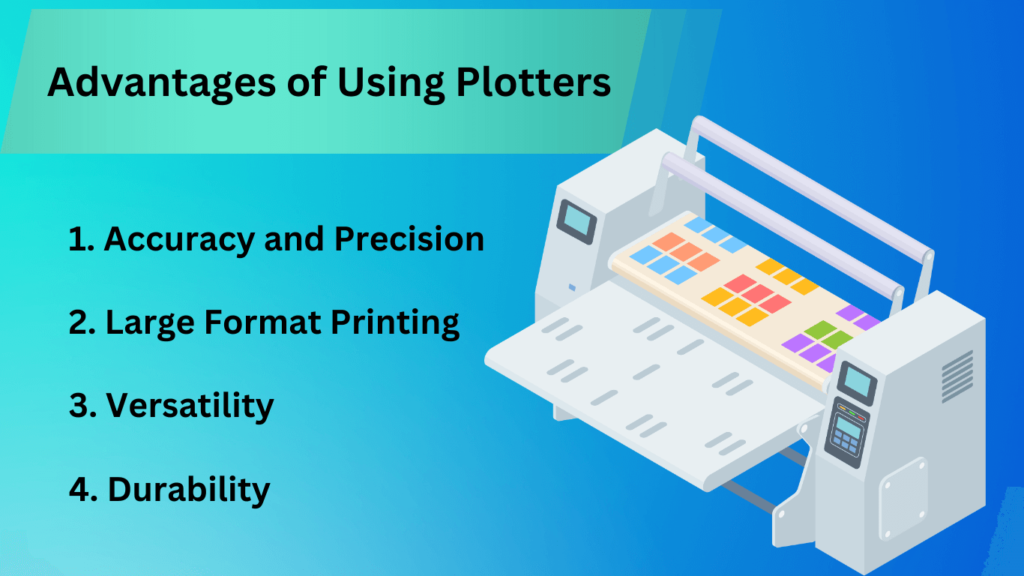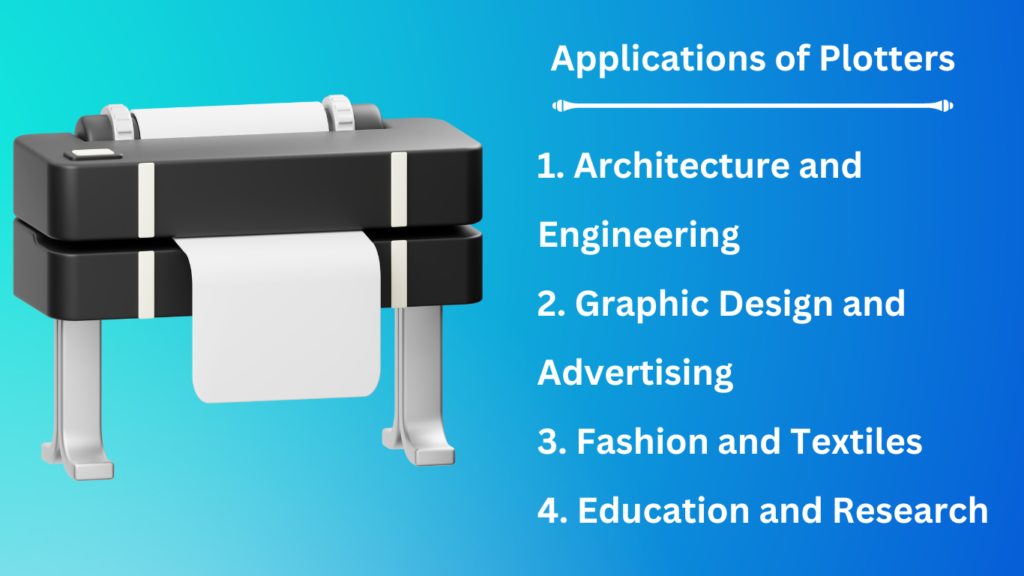What is Plotter in Computer : In the world of computers, we often come across various devices that aid in our daily tasks. One such device that has been widely used in the computer industry is a plotter. But what exactly is a plotter? How does it work? And what are its applications?

What is Plotter in Computer?
A plotter is a computer peripheral that is used to produce high-quality graphics, designs, and images. Unlike printers, which are mainly used for text documents, plotters are specifically designed for creating large-scale, precise, and detailed visuals.
Plotters use a combination of pens, markers, or other writing tools to draw continuous lines on paper or other materials, resulting in accurate and intricate representations.
Types of Plotters
There are several types of plotters available in the market, each with its unique features and capabilities. The two main categories of plotters are:
Pen Plotters:
Pen plotters are the most common type of plotters. They use a pen or a marker to create drawings by moving the pen across the paper. Pen plotters are known for their high precision and can produce detailed and complex designs with ease.
Pen plotters operate by moving a pen or a marker across the paper to create drawings. The plotter receives instructions from a computer, which tells it where to move the pen and what to draw.
The pen is mounted on a carriage that moves horizontally and vertically across the paper. The plotter carefully controls the movements of the pen to create precise lines and shapes.
Electrostatic Plotters:
Electrostatic plotters, also known as electrostatic printers, use static electricity to create images. These plotters have a charged surface that attracts toner particles, which are then transferred onto the paper. Electrostatic plotters are often used in commercial printing and can produce high-quality prints quickly.
Electrostatic plotters, on the other hand, use static electricity to create images. These plotters have a charged surface, typically a drum or a belt, which attracts toner particles. The plotter receives digital data from a computer and uses an electrostatic charge to transfer the toner particles onto the paper, creating the desired image. The process is similar to that of a laser printer, but on a larger scale.
Advantages of Using Plotters | Advantages of Plotters
Now that we understand how plotters work, let’s explore the advantages they offer over other printing devices.

1. Accuracy and Precision:
Plotters are renowned for their accuracy and precision. They can draw intricate designs with impeccable detail, making them ideal for architectural blueprints, engineering diagrams, and other technical drawings.
2. Large Format Printing:
Unlike traditional printers, plotters can handle large paper sizes and produce prints of various lengths. This makes them perfect for creating banners, posters, and other oversize visuals.
3. Versatility:
Plotters can work with a wide range of materials, including paper, cardboard, vinyl, and fabric. This versatility allows for endless creative possibilities and makes plotters suitable for a variety of applications.
4. Durability
Plotters are built to last. They are designed to handle heavy workloads and are often used in industrial settings. With proper maintenance, a plotter can serve you for many years, making it a cost-effective investment.
Applications of Plotters
With their unique capabilities, plotters find applications in various industries. Let’s explore some of the key areas where plotters are widely used:

1. Architecture and Engineering
Plotters are extensively used in architecture and engineering for creating precise blueprints, floor plans, and construction drawings. The accuracy and large format printing capabilities of plotters make them invaluable tools in these fields.
2. Graphic Design and Advertising
Plotters are popular among graphic designers and advertising professionals for creating eye-catching posters, banners, and signage. The ability to produce high-quality prints on different materials allows for creative freedom and impact visual communication.
3. Fashion and Textiles
Plotters are also utilized in the fashion and textile industry for creating patterns, designs, and prototypes. The versatility of plotters enables designers to experiment with different fabrics and materials, bringing their visions to life.
4. Education and Research
Plotters are valuable tools in educational institutions and research facilities. They are used for creating educational charts, scientific diagrams, and visual aids that enhance learning and facilitate understanding.
Plotter vs Printer: What’s the Difference?
While both plotters and printers are used for producing visuals, there are some key differences between the two.
The main difference lies in the way they operate. Printers work by applying ink or toner onto paper in small dots, whereas plotters use pens or markers to draw continuous lines. This fundamental distinction makes plotters more suitable for creating large-scale drawings and designs that require precision and accuracy.
Additionally, plotters are typically larger in size compared to printers. They are designed to handle bigger paper sizes and are capable of producing prints that are several feet long. Printers, on the other hand, are generally smaller and more compact, making them suitable for everyday printing tasks.
Choosing the Right Plotter for Your Needs
Now that you have a good understanding of plotters, it’s essential to know how to choose the right plotter for your specific requirements. Here are some factors to consider:
1. Size and Printing Speed
Determine the size of the prints you need and the speed at which you require them. This will help you choose a plotter that can handle your desired output efficiently.
2. Resolution and Detail
Consider the level of detail you require in your prints. Higher resolutions will result in more precise and accurate drawings.
3. Connectivity and Compatibility
Ensure that the plotter you choose is compatible with your computer system and offers the connectivity options you need, such as USB or network connectivity.
4. Cost and Maintenance
Take into account the initial cost of the plotter, as well as the cost of replacement parts and maintenance. Consider your budget and the long-term costs involved.
Maintenance and Troubleshooting Tips for Plotters
To ensure optimal performance and longevity of your plotter, regular maintenance is crucial. Here are some maintenance and troubleshooting tips to keep your plotter in top condition:
1. Cleaning
Regularly clean the plotter’s components, such as the pen or the toner drum, to prevent buildup or clogging. Follow the manufacturer’s guidelines for cleaning procedures.
2. Calibration
Periodically calibrate your plotter to ensure accurate and precise drawings. Calibration adjusts the plotter’s settings to compensate for any deviations or errors.
3. Software Updates
Keep your plotter’s software up to date by installing the latest updates and drivers. This will ensure compatibility with new operating systems and enhance performance.
4. Troubleshooting
Familiarize yourself with common plotter issues and their solutions. This will help you troubleshoot minor problems and avoid unnecessary downtime.
Conclusion :
In conclusion, plotters are powerful devices that have revolutionized the way we create and reproduce large-scale visuals. From architecture and engineering to graphic design and fashion, plotters find applications in various industries. Their accuracy, precision, and versatility make them indispensable tools for professionals who require detailed and high-quality prints.
Whether you are an architect, engineer, designer, or educator, understanding the capabilities and workings of plotters can help you make informed decisions and maximize the potential of these remarkable devices. So, the next time you come across a plotter, you’ll know exactly what it is and appreciate the intricate art it can create.
So that’s all about “What is Plotter in Computer | Types of Plotters | Advantages of Using Plotters | Applications of Plotters“.
Pingback: TOP 07 Applications of Computer in Education - Printer X Pert
Pingback: पत्र-लेखन और ई-मेल में अन्तर | 5 Difference between a Letter and Email in Hindi - Application & Info